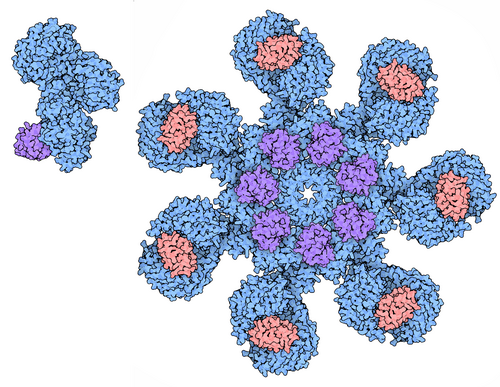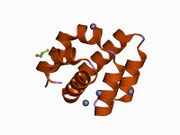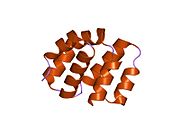Biology:APAF1
 Generic protein structure example |
Apoptotic protease activating factor 1, also known as APAF1, is a human homolog of C. elegans CED-4 gene.[1][2][3]
Function
The protein was identified in the laboratory of Xiaodong Wang as an activator of caspase-3 in the presence of cytochromeC and dATP.[4] This gene encodes a cytoplasmic protein that forms one of the central hubs in the apoptosis regulatory network. This protein contains (from the N terminal) a caspase recruitment domain (CARD), an ATPase domain (NB-ARC), few short helical domains and then several copies of the WD40 repeat domain. Upon binding cytochrome c and dATP, this protein forms an oligomeric apoptosome. The apoptosome binds and cleaves Procaspase-9 protein, releasing its mature, activated form. The precise mechanism for this reaction is still debated though work published by Guy Salvesen suggests that the apoptosome may induce caspase-9 dimerization and subsequent autocatalysis.[5] Activated caspase-9 stimulates the subsequent caspase cascade that commits the cell to apoptosis.
Alternative splicing results in several transcript variants encoding different isoforms.[1]
Structure
APAF1 contains a CARD domain with a Greek key motif composed of six helices, a Rossman fold nucleotide binding domains, a short helical motif and a winged-helix domain.[6]
Interactions
APAF1 has been shown to interact with:
References
- ↑ 1.0 1.1 "Entrez Gene: APAF1 apoptotic peptidase activating factor 1". https://www.ncbi.nlm.nih.gov/sites/entrez?Db=gene&Cmd=ShowDetailView&TermToSearch=317.
- ↑ "Apaf-1, a human protein homologous to C. elegans CED-4, participates in cytochrome c-dependent activation of caspase-3". Cell 90 (3): 405–13. Aug 1997. doi:10.1016/S0092-8674(00)80501-2. PMID 9267021.
- ↑ "Assignment of apoptotic protease activating factor-1 gene (APAF1) to human chromosome band 12q23 by fluorescence in situ hybridization". Cytogenetics and Cell Genetics 87 (3–4): 252–3. 1999. doi:10.1159/000015436. PMID 10702682.
- ↑ "Cytochrome c and dATP-dependent formation of Apaf-1/caspase-9 complex initiates an apoptotic protease cascade". Cell 91 (4): 479–89. Nov 1997. doi:10.1016/s0092-8674(00)80434-1. PMID 9390557.
- ↑ "The apoptosome activates caspase-9 by dimerization". Molecular Cell 22 (2): 269–75. Apr 2006. doi:10.1016/j.molcel.2006.03.009. PMID 16630894.
- ↑ "Structure of the apoptotic protease-activating factor 1 bound to ADP". Nature 434 (7035): 926–33. Apr 2005. doi:10.1038/nature03465. PMID 15829969. Bibcode: 2005Natur.434..926R.
- ↑ 7.0 7.1 "Induced inhibition of ischemic/hypoxic injury by APIP, a novel Apaf-1-interacting protein". The Journal of Biological Chemistry 279 (38): 39942–50. Sep 2004. doi:10.1074/jbc.M405747200. PMID 15262985.
- ↑ 8.0 8.1 "Bcl-XL interacts with Apaf-1 and inhibits Apaf-1-dependent caspase-9 activation". Proceedings of the National Academy of Sciences of the United States of America 95 (8): 4386–91. Apr 1998. doi:10.1073/pnas.95.8.4386. PMID 9539746. Bibcode: 1998PNAS...95.4386H.
- ↑ 9.0 9.1 "Caspase-9, Bcl-XL, and Apaf-1 form a ternary complex". The Journal of Biological Chemistry 273 (10): 5841–5. Mar 1998. doi:10.1074/jbc.273.10.5841. PMID 9488720.
- ↑ 10.0 10.1 "A novel enhancer of the Apaf1 apoptosome involved in cytochrome c-dependent caspase activation and apoptosis". The Journal of Biological Chemistry 276 (12): 9239–45. Mar 2001. doi:10.1074/jbc.M006309200. PMID 11113115.
- ↑ "Cytochrome c and dATP-dependent formation of Apaf-1/caspase-9 complex initiates an apoptotic protease cascade". Cell 91 (4): 479–89. Nov 1997. doi:10.1016/s0092-8674(00)80434-1. PMID 9390557.
- ↑ "Negative regulation of the Apaf-1 apoptosome by Hsp70". Nature Cell Biology 2 (8): 476–83. Aug 2000. doi:10.1038/35019510. PMID 10934467.
External links
- Human APAF1 genome location and APAF1 gene details page in the UCSC Genome Browser.
- Overview of all the structural information available in the PDB for UniProt: O14727 (Apoptotic protease-activating factor 1) at the PDBe-KB.
Further reading
- "The WD repeat: a common architecture for diverse functions". Trends in Biochemical Sciences 24 (5): 181–5. May 1999. doi:10.1016/S0968-0004(99)01384-5. PMID 10322433.
- "Diva vaccines that reduce virus transmission". Journal of Biotechnology 73 (2–3): 195–205. Aug 1999. doi:10.1016/S0168-1656(99)00121-2. PMID 10486928.
- "Construction of expression-ready cDNA clones for KIAA genes: manual curation of 330 KIAA cDNA clones". DNA Research 9 (3): 99–106. Jun 2002. doi:10.1093/dnares/9.3.99. PMID 12168954.
- "Role of Apaf-1, a key regulator of apoptosis, in melanoma progression and chemoresistance". Experimental Dermatology 14 (11): 811–8. Nov 2005. doi:10.1111/j.1600-0625.2005.00360.x. PMID 16232302.
- "Apaf-1, a human protein homologous to C. elegans CED-4, participates in cytochrome c-dependent activation of caspase-3". Cell 90 (3): 405–13. Aug 1997. doi:10.1016/S0092-8674(00)80501-2. PMID 9267021.
- "Cytochrome c and dATP-dependent formation of Apaf-1/caspase-9 complex initiates an apoptotic protease cascade". Cell 91 (4): 479–89. Nov 1997. doi:10.1016/S0092-8674(00)80434-1. PMID 9390557.
- "Prediction of the coding sequences of unidentified human genes. VIII. 78 new cDNA clones from brain which code for large proteins in vitro". DNA Research 4 (5): 307–13. Oct 1997. doi:10.1093/dnares/4.5.307. PMID 9455477.
- "Caspase-9, Bcl-XL, and Apaf-1 form a ternary complex". The Journal of Biological Chemistry 273 (10): 5841–5. Mar 1998. doi:10.1074/jbc.273.10.5841. PMID 9488720.
- "Bcl-XL interacts with Apaf-1 and inhibits Apaf-1-dependent caspase-9 activation". Proceedings of the National Academy of Sciences of the United States of America 95 (8): 4386–91. Apr 1998. doi:10.1073/pnas.95.8.4386. PMID 9539746. Bibcode: 1998PNAS...95.4386H.
- "Autoactivation of procaspase-9 by Apaf-1-mediated oligomerization". Molecular Cell 1 (7): 949–57. Jun 1998. doi:10.1016/S1097-2765(00)80095-7. PMID 9651578.
- "Apaf1 (CED-4 homolog) regulates programmed cell death in mammalian development". Cell 94 (6): 727–37. Sep 1998. doi:10.1016/S0092-8674(00)81732-8. PMID 9753320.
- "Diva, a Bcl-2 homologue that binds directly to Apaf-1 and induces BH3-independent cell death". The Journal of Biological Chemistry 273 (49): 32479–86. Dec 1998. doi:10.1074/jbc.273.49.32479. PMID 9829980.
- "WD-40 repeat region regulates Apaf-1 self-association and procaspase-9 activation". The Journal of Biological Chemistry 273 (50): 33489–94. Dec 1998. doi:10.1074/jbc.273.50.33489. PMID 9837928.
- "Boo, a novel negative regulator of cell death, interacts with Apaf-1". The EMBO Journal 18 (1): 167–78. Jan 1999. doi:10.1093/emboj/18.1.167. PMID 9878060.
- "Ordering the cytochrome c-initiated caspase cascade: hierarchical activation of caspases-2, -3, -6, -7, -8, and -10 in a caspase-9-dependent manner". The Journal of Cell Biology 144 (2): 281–92. Jan 1999. doi:10.1083/jcb.144.2.281. PMID 9922454.
- "An APAF-1.cytochrome c multimeric complex is a functional apoptosome that activates procaspase-9". The Journal of Biological Chemistry 274 (17): 11549–56. Apr 1999. doi:10.1074/jbc.274.17.11549. PMID 10206961.
- "Cytochrome c and dATP-mediated oligomerization of Apaf-1 is a prerequisite for procaspase-9 activation". The Journal of Biological Chemistry 274 (25): 17941–5. Jun 1999. doi:10.1074/jbc.274.25.17941. PMID 10364241.
- "Structural basis of procaspase-9 recruitment by the apoptotic protease-activating factor 1". Nature 399 (6736): 549–57. Jun 1999. doi:10.1038/21124. PMID 10376594. Bibcode: 1999Natur.399..549Q.
- "A soluble version of the receptor-like protein tyrosine phosphatase kappa stimulates neurite outgrowth via a Grb2/MEK1-dependent signaling cascade". Molecular and Cellular Neurosciences 13 (6): 441–9. Jun 1999. doi:10.1006/mcne.1999.0758. PMID 10383829.
 |









